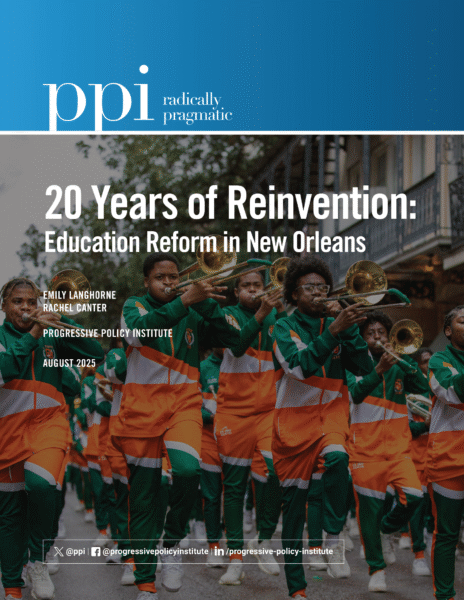WASHINGTON — Two decades after Hurricane Katrina devastated New Orleans, a new report from the Progressive Policy Institute (PPI) reveals how the city’s complete overhaul of its public education system yielded unprecedented academic gains, offering a blueprint to transform struggling school districts nationwide.
The report, “20 Years of Reinvention: Education Reform in New Orleans,” chronicles the city’s bold post-Katrina move to convert its traditional public schools into public charter schools. The move radically redefines the role of the district and shows student achievement surging across nearly every metric: test scores, graduation rates, college enrollment, and school accountability ratings.
“New Orleans proves that it is possible to build a public education system that is both excellent and equitable,” said Rachel Canter, Director of Education Policy at PPI and co-author of the report. “This transformation didn’t happen overnight; it required political courage, sustained leadership, and a relentless focus on student outcomes.”
Among the key findings:
- The percentage of New Orleans students scoring at “basic or above” on fourth-grade English tests rose from 44% in 2005 to 54% in 2024, on more rigorous exams.
- High school graduation rates climbed from 54% in 2004 to nearly 79% in 2023.
- College entry rates jumped from 37% to 65%, now surpassing the state average.
The report attributes these gains to a powerful mix of school autonomy, strong accountability, citywide public school choice, and a robust ecosystem of nonprofit partners.
“New Orleans didn’t just rebuild its schools, it reinvented the entire system,” said co-author Emily Langhorne. “The city separated the work of managing schools from operating them, embraced diverse school models, and prioritized student achievement above bureaucratic tradition.”
While acknowledging that New Orleans’ unique circumstances may not be replicable everywhere, the authors emphasize that the core principles of autonomy, accountability, and choice can be adapted to other urban districts facing systemic failure.
Read and download the report here.

The Reinventing America’s Schools Project seeks to refocus national leadership around proven strategies to improve public schools and educational achievement. We believe that American public schools must prepare children academically to be successful adults and citizens; families should have a voice in their child’s education, including a choice within the public system to find a school that best fits their child’s needs; and, though education is the province of the states, the federal government must protect the promise that every child will have access to a quality public education.
Founded in 1989, PPI is a catalyst for policy innovation and political reform based in Washington, D.C. Its mission is to create radically pragmatic ideas for moving America beyond ideological and partisan deadlock. Find an expert and learn more about PPI by visiting progressivepolicy.org. Follow us @PPI.
###
Media Contact: Ian O’Keefe – iokeefe@ppionline.org



